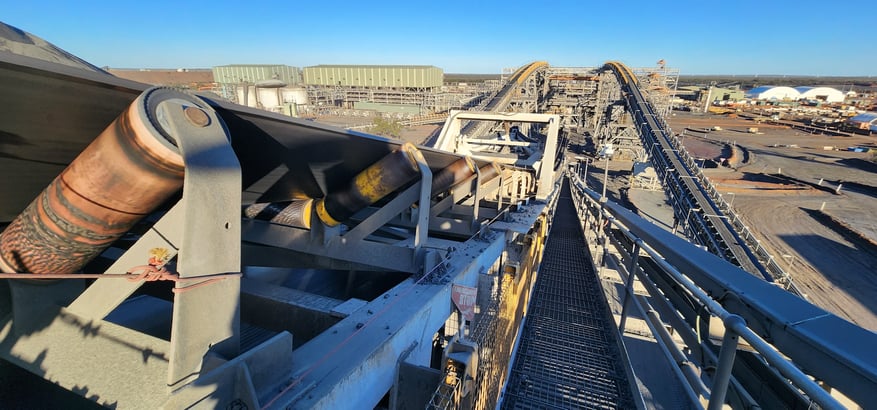Tail pulleys might sit at the end of the conveyor belt, but their role is anything but minor. They maintain belt tension, guide alignment and keep everything running smoothly.
Your choice of pulley lagging can make a big difference to system performance and maintenance schedules. With the right selection, resources operators can efficiently handle abrasive, wet and high-capacity loads.
This post explores the different lagging options available for tail pulleys. We outline their uses, advantages and the factors to consider when formulating a solution for your site.
Why Lagging Matters for Tail Pulleys
Lagging provides a protective cover to the pulley surface. For tail pulleys, it helps with:
-
Friction and Tracking: Provides grip against the belt, helping reduce slippage and improve alignment.
-
Wear Protection: Shields the shell from abrasive material, extending service life.
-
Build-Up Prevention: Some lagging surfaces help shed dirt and moisture from the unit, reducing the risk of blockages.
-
Safety and Compliance: Proper lagging reduces the likelihood of sudden failures, improving site safety.
Lagging Options for Tail Pulleys
Rubber Lagging
-
Smooth Rubber: A straightforward option for lighter-duty applications, offering basic protection and grip.
-
Diamond-Grooved Rubber: The most common choice for mining tail pulleys. Diamond grooves channel water and fines away from the belt, reducing slippage and material build-up.
-
Chevron-Grooved Rubber: Similar to diamond grooves but with directional channels, ideal for high-moisture or slurry-prone conditions.
Best for: Conveyors on sites where moisture and carry back are common challenges.
Ceramic Lagging
-
Plain Ceramic Tiles: Extremely durable and resistant to abrasion.
-
Dimpled Ceramic: Increases grip and is particularly effective for high-tension applications.
-
Hybrid Ceramic/Rubber: Combines grip and abrasion resistance with added flexibility.
Polyurethane Lagging
Best for: Operations with chemical exposure or corrosive materials.
Flame-Resistant Lagging
Where a fire risk is present, this lagging provides an added layer of safety.
What to Consider When Selecting Lagging
Managers and operators should consider:
-
Load Characteristics: Abrasiveness, moisture levels, particle size and potential chemical exposure.
-
Environmental Conditions: Dust levels, humidity and temperature extremes.
-
Conveyor Speed and Load Size: Higher speeds and loads increase the need for durable, high-traction surfaces.
-
Maintenance Goals: Some lagging options are designed to reduce material build-up and simplify cleaning, reducing maintenance time.
-
Compliance Requirements: Fire-resistant options may be mandatory in certain applications.
Why You Should Choose Replacement Over Refurbishment
-
A longer service life
-
Lower long-term maintenance costs
-
Elimination of hidden defects
-
Compliance with current engineering standards
The Promet Difference
-
Manufactured with corrosion-resistant materials and reinforced lagging
-
Quality tested for pressure, tension, vibration and load bearing capacity
-
Backed by an 18-month full replacement guarantee
-
Delivered quickly through our trusted supply chain
Receive a Free Quote for Lagged Tail Pulleys
For a free, zero obligation quote returned in 5 days, submit your drawings here.




